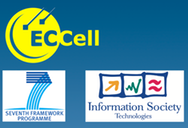Following ligation, copies are bound to immobilized templates by H-bridges between Watson-Crick base pairs. Dehybridization is a chemical operation which cleaves these H-bonds. Cleavage of H-bonds is most effectively achieved by applying a pulse of alkaline conditions (pH12) causing the deprotonation of T(U) and G’s at their imide or amidine moieties. Pulse generation can either take place by a localized electrolysis of water or the reduction of quinones absorbed on a microelectrode. The reduced quinone will uptake protons from water thus releasing a hydroxide signal which diffuses into the matrix causing copy liberation while leaving the original immobilized.
Site Navigation[Skip]
- Home
- Overview
- Partners
- Research
- Final Report
- Deliverables
- Deliverables List
- Individual Deliverables
- ECCell_D1_1 Development of replication chemistry running in the electronic cel
- ECCell_D1_2 Integration of high information content replication in ECCells
- ECCell_D2_2 Mid-term report on programmable containment
- ECCell_D3_4 Autonomous activation of isothermal ligation
- ECCell_D4_3 ECCell-based integration in microscale chemical processing networks.
- ECCell_D5_1 UML specification of design space for ECCells.
- ECCell_D5_3 Completed software system _ User Manual
- ECCell_D5_3 Completed software system for programming and optimizing ECCells
- ECCell_D6_1 Demonstration of sequence-specific DNA processing with programmable ECCell gels
- ECCell_D7_1 Report on ECLT Workshop and Training Activities
- ECCell_D7_2 Final plan for the use and dissemination of information
- 2010-11 Progress Report 3
- Midterm Report
- 2009-10 Progress Report 2
- 2008-9 Progress Report I
- Review reports
- Publications
- ICT
- Workplan
- Workshops
- Kickoff Workshop 2008
- Workshop July 2009
- 1st Review Workshop 2009
- Workshop Apr 2010
- Alife XII Session
- Workshop Sep 2010
- 2nd Review Workshop
- ECAL, Special session on Chem-Bio ICT with COBRA - Paris
- FET11 Conference special session on Chem-Bio ICT - Budapest
- ECCell-MATCHIT Joint Workshop
- Workshop Sep 2011
- Workshop ECHS 2011
- ECCell Final Review
- Ethics
- Proposal
- Press
- Sitemap
Sidebar[Skip]
Core responsibilities
WP1 leader : Günter von Kiedrowski
Related Links
- EU ICT : Programme
- Future and Emerging Technologies
- Programme : FET Pro-Active
- Bio-chemistry based IT
- COBRA
Coordination of the Bio-Chem-IT Research Area - MATCHIT
FP7 EU Project - Programmable Artificial Cell Evolution (PACE)
- Systems Chemistry
- Living Technology
- Unconventional Computing
